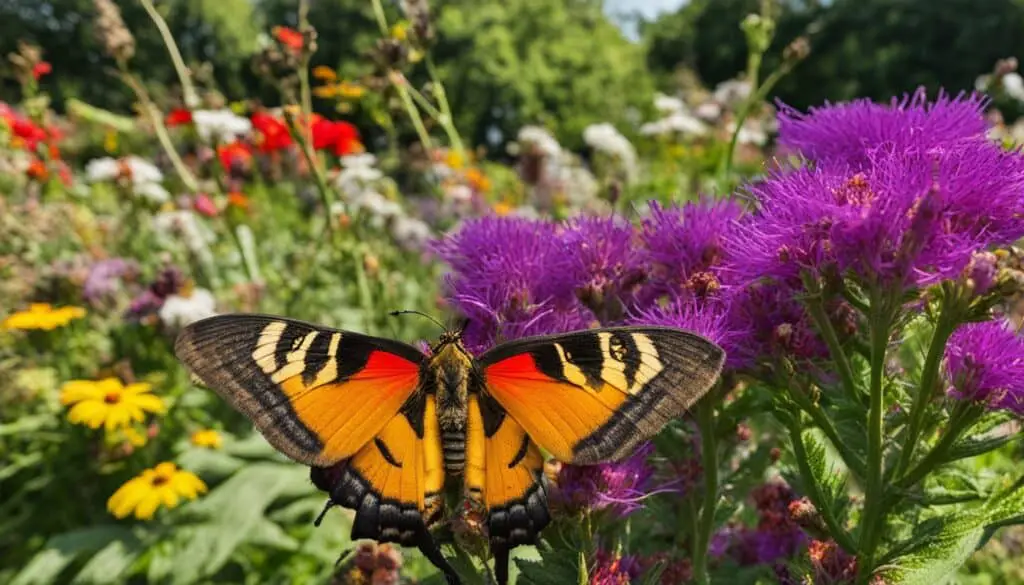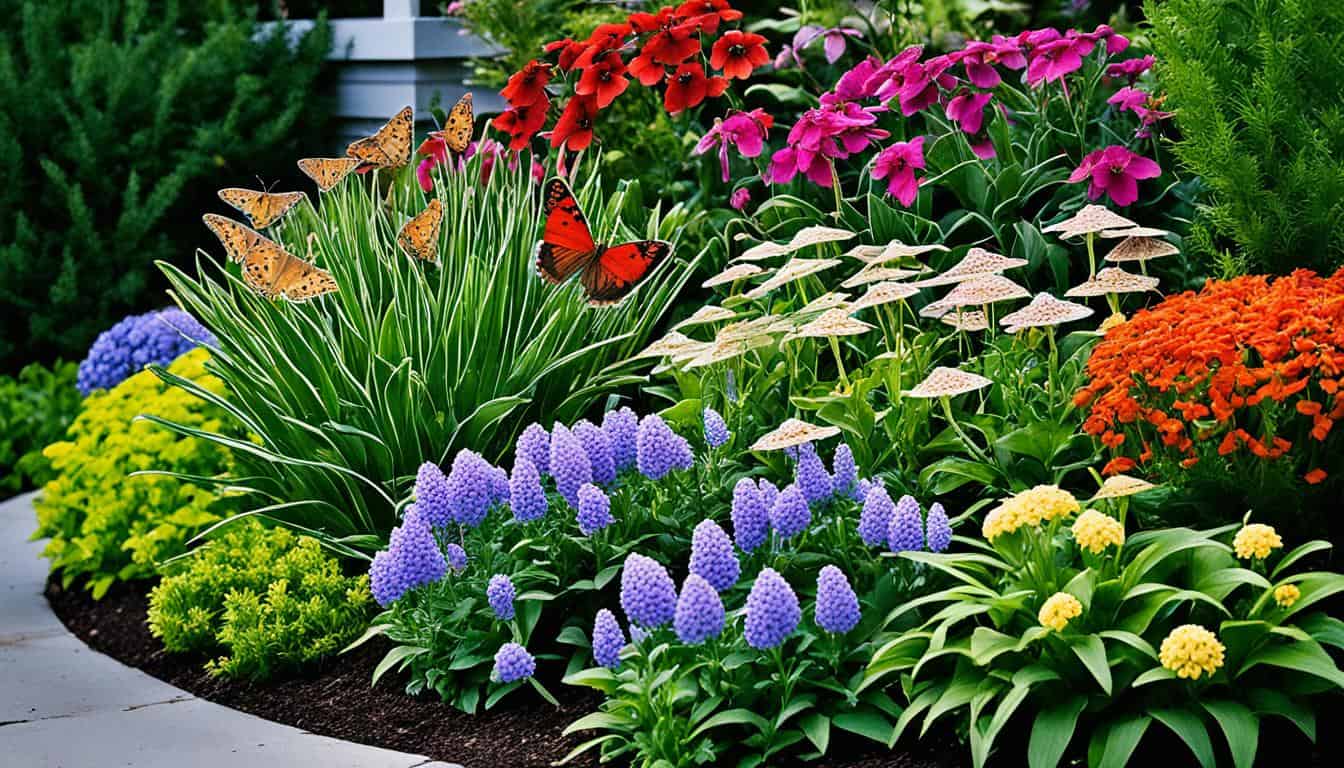Have you thought about making your garden a lovely spot for native moths? It’s easier than you might guess. Make your space like their natural home. Plant evening-scented flowers that smell wonderful at night. This will draw moths to your garden. What else can you do to welcome these special insects?
When aiming for garden moth attractants, think about what native moths need. This includes choosing the right plants and creating cozy shelters. Your efforts will not only make your garden more diverse but also help conserve these important pollinators.
Understanding the Importance of Moths in Your Garden
Moths are critical for keeping ecosystems in balance. Many native moths help scenery and influence more than just their homes. They affect the environment on a larger scale.
Role in Pollination
Moths act as essential pollinators, aiding in plant reproduction. Unlike butterflies, they pollinate plants that bloom at night. This helps many plant species survive. Their history with farming shows how much they help with plant diversity.
Food Source for Wildlife
They are a key food for many animals, like bats and birds. There are over 11,000 species in North America, ensuring food for night hunters. Moths help keep the food chain active. Caring for moths in your garden can improve the ecosystem.
Choosing Moth-Friendly Plants
To make moths feel at home, start by picking the right plants. The best species will boost your garden’s moth-friendly vibe. This part will help you add moth-attracting flowers and native host plants for moth caterpillars.
Night-Scented Flowers
Night-scented blooms pull moths in. Plants like sacred Datura and evening primrose let out smells that moths love. They do this after dark, setting the stage for moths to visit.
Nectar-Bearing Plants
Plants with nectar are key for moth-friendly gardening. They feed moths that eat nectar, day or night. A mix of local flowers means moths will have food all the time, helping them thrive.
Host Plants for Caterpillars
Focus on native host plants for moth caterpillars for moths with different adult stages. The right plants help caterpillars grow. This supports the full life cycle of different moth types. It’s good for their conservation.
Incorporating Native Plants
Gardening with native plants does more than make your yard look nice. It helps create a thriving ecosystem. These plants work well with local animals, especially moths. This partnership helps keep nature in harmony and lowers the work needed to care for your garden.
Benefits of Native Species
Native plants offer many advantages. They fit in perfectly with the wildlife in your area, moths included. Because they’ve grown up in the same conditions, they need less water and care. This also means using fewer chemicals. Native plants are also a natural way to draw in local moths. These insects know just how to use these plants.
Examples of Native Plants to Grow
Start by planting native flowers, shrubs, and trees in your garden. Here are some great choices:
| Plant Type | Examples | Benefits |
|---|---|---|
| Flowering Plants | Goldenrod, Coneflower | Provide nectar for adult moths |
| Shrubs | Serviceberry, Spicebush | Offer shelter and food for caterpillars |
| Trees | Oak, Willow | Host plants for numerous moth species |
Adding native plants to your garden has many good points. It helps your garden work well with nature while creating a healthy, beautiful space for everyone.
Creating a Moth Habitat
Creating a garden that’s friendly to moths is about more than the plants you choose. It’s a holistic process that mimics their natural homes. There are key aspects to include:
- Diverse Flora: Plant a variety of flowers and host plants for caterpillars. This mix helps moths throughout all life stages and boosts their numbers.
- Undisturbed Leaf Litter: Many moths use leaf litter for laying eggs and seeking cover. By leaving parts of your garden untouched, you create a perfect sanctuary for them.
- Woody Debris: Adding logs and branches not only looks nice but offers moths hiding and breeding places. It enriches your garden for wildlife too.
- Water Sources: Moths are attracted to small water features. Maintain these areas well to avoid creating places where pests can breed.
- Avoid Pesticides: Using fewer pesticides safeguards moths and their young. This makes your garden a safer home for these insects.
Designing a space where moths can flourish is all about the right elements. With a thoughtful setup, your garden supports moth life and becomes more diverse.
Minimizing Garden Maintenance
Reducing the time spent on garden care makes it more attractive for moths and other creatures. A low-maintenance approach also supports eco-friendly garden habits.
Leaving Plant Debris
Leaving fallen leaves and old plant stems in your garden is a good idea. They create hiding places for moth caterpillars and other animals. This action shows how important plant debris is for wildlife. It helps in creating a balanced place where moths can live through their different life stages.
Avoiding Over-Mulching
Over-mulching is bad for eco-friendly gardens. Too much mulch harms the soil and lessens places for moths to live. Using a light layer of mulch is better. It keeps the soil moist, stops weeds, and doesn’t harm your garden’s ecosystem.
Opting for Organic Gardening
Organic gardening has many benefits of organic gardening for your garden. You create a balanced ecosystem by avoiding pesticides and synthetic chemicals. This helps native moths and other helpful bugs to grow.
Using methods like planting with companions and natural pest control attracts more moths. It also makes your garden healthier. Plus, you won’t need as many chemicals.
Organic methods support the growth of ‘good’ insects and contribute to overall garden health, creating an inviting habitat for native moths.

- Composting: It makes your soil better for plants.
- Mulching: Helps keep moisture and stops weeds.
- Companion Planting: Certain plants keep pests away and bring in good bugs.
| Practice | Benefits |
|---|---|
| Composting | Enhances soil health and nutrient content |
| Mulching | Retains soil moisture and controls weeds |
| Companion Planting | Promotes biodiversity and pest control |
Choosing organic gardening helps your garden and native moths. It makes a place where they can live well. This method is good for your garden and looks beautiful too.
Reducing Pesticide Use
Pesticides really harm moths, affecting their survival and your garden’s health. By learning about these harms and trying natural solutions, you support more wildlife. This includes helpful bugs and moths.
Impacts of Pesticides on Moths
Pesticides are dangerous for moths, affecting all their life stages. They kill moths and mess up how they reproduce. This loss hurts the ecosystem because moths help pollinate and feed other wildlife.
Natural Pest Control Alternatives
Using natural ways to control pests is both safer and better for the planet. Things like inviting ladybugs and lacewings to your garden can help. So can using special plant sprays and choosing the right plants.
| Natural Pest Control Methods | Benefits |
|---|---|
| Encouraging Predators | Reduces pest populations naturally |
| Botanical Insecticides | Minimizes chemical residues while controlling pests |
| Companion Planting | Creates a diverse ecosystem that deters pests |
Knowing how bad pesticides are for moths is key. So is using natural pest control in your garden. This protects moths and helps make our world healthier.
Lighting Considerations for Moth Attraction
Good garden lighting is key for attracting moths safely. Moths are drawn to light naturally. Choosing the right lights can make your garden a perfect place for these night pollinators. It does this without affecting their habits.
Using Soft Lighting
Choosing soft lighting is important to lure moths. Warm, red, and orange lights attract them without harm. These lights feel like natural twilight, making moths feel at home. This encourages them to pollinate your garden without getting lost. It’s the best option for drawing moths to your garden and caring for them.
Avoiding Harsh Lights
Avoid bright white or blue lights since they may confuse moths. These lights aren’t good because they can lead moths to danger. They might get too close to predators or other threats. It’s best to use gentle, soft lights to keep moths safe and your garden friendly for them.
FAQ
How do you attract native moths to your garden?
Attract native moths by planting evening-scented flowers. Add a variety of plants and create a good home for them. Use native plants and keep your garden less tidy to help moths.
What is the importance of moths in my garden?
Moths help pollinate plants and are food for animals like bats. They are key to a healthy garden’s ecosystem and should be protected.
What moth-friendly plants should I choose?
Choose night-scented flowers and nectar plants for moths. Also, pick host plants for caterpillars. This helps their life cycle.
Why should I incorporate native plants in my garden?
Native plants help create a great moth environment. They don’t need as much care and they support the local ecosystem. Native plants attract certain moth species.
How can I create a suitable moth habitat?
To make a place for moths, plant a variety of flowers. Add leaf litter and host plants for caterpillars. This makes your garden more like their home.
How do I minimize garden maintenance to benefit moths?
Let leaves and old plant stems stay in your garden. They provide safe places for moth babies and other creatures. Don’t use too much mulch to keep things natural.
What are the benefits of organic gardening for moths?
Organic gardening is good for moths because it doesn’t use harmful chemicals. It keeps their environment safe and promotes healthy garden bugs.
How does pesticide use affect moths?
Pesticides harm moths at every stage of their life. Using natural ways to control pests is better. This keeps your plants safe and moths alive.
How should I consider lighting to attract moths?
Use soft lights in your garden to draw in moths safely. Bright lights can confuse and hurt moths. This protects them while enjoying your garden.







